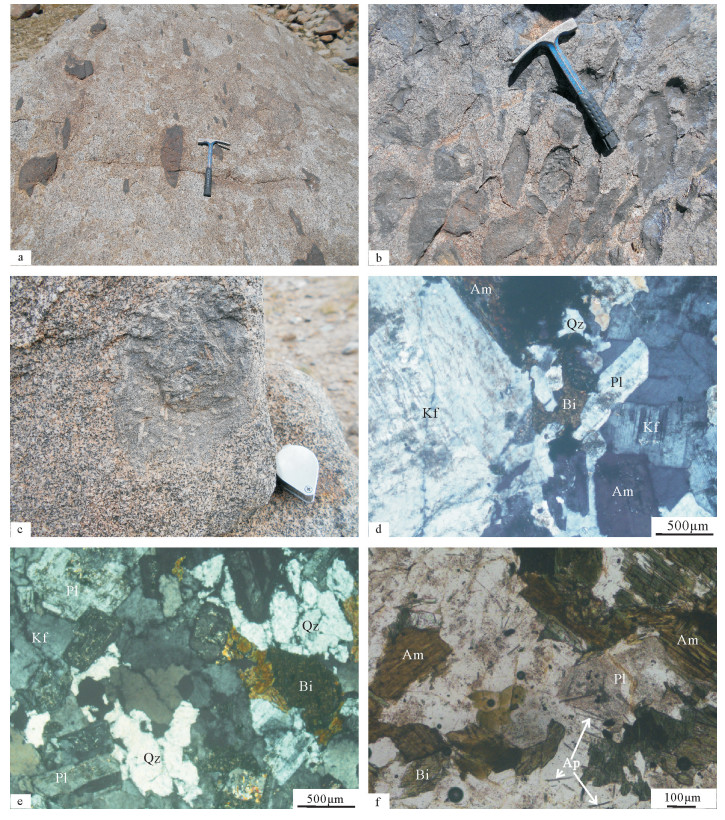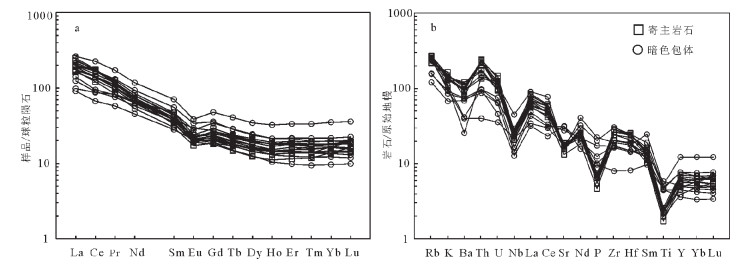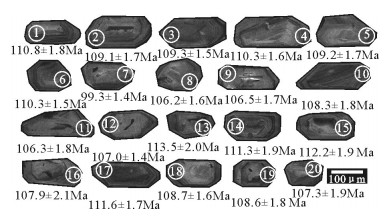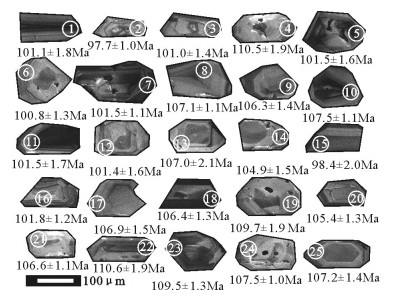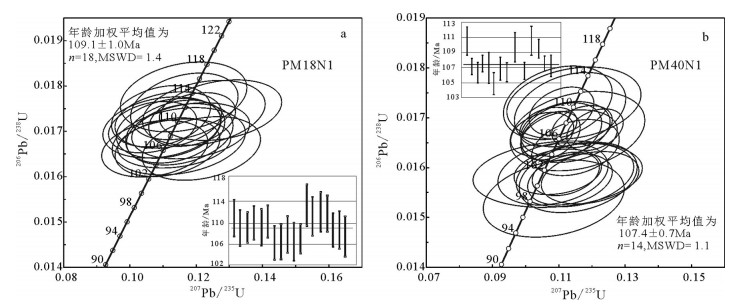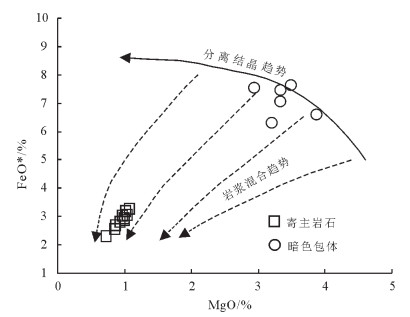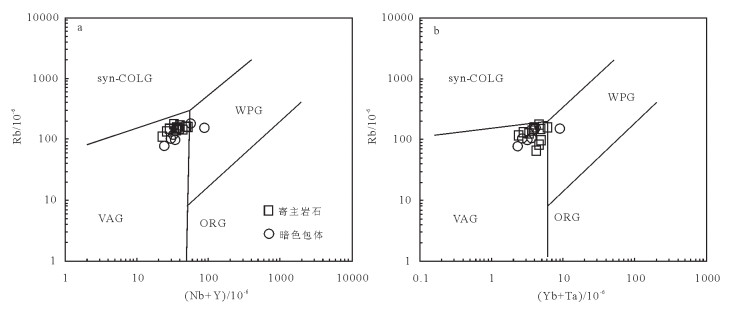Geochronology, geochemistry and geodynamic significance of Awengcuo composite pluton and its dark microgranular enclaves in the north of Tibet
-
摘要:
对班公湖-怒江缝合带西段阿翁错复式岩体及其暗色微粒包体开展了岩石学、全岩地球化学及同位素年龄研究。结果表明,阿翁错复式岩体中出露大量闪长质暗色微粒包体,包体具典型的火成结构,发育针状磷灰石。寄主岩与包体均为准铝质、高钾钙碱性-钾玄岩系列过渡岩石,主要氧化物含量在Harker图解上具有良好的线性关系,稀土元素配分曲线和微量元素原始地幔标准化蛛网图具有高度的一致性,表明二者具有强烈的地球化学亲源关系,且经历了相似的岩浆演化过程;主量、微量元素同分母协变图中包体和寄主岩表现为良好的线性关系,表明二者之间的演化与岩浆混合作用关系密切;包体的原始岩浆可能来源于受俯冲带流体交代的地幔楔,寄主岩为幔源岩浆与熔融下地壳岩浆混合的产物,以熔融下地壳岩浆为主。寄主岩和暗色微粒包体的成岩年龄分别为109.1±1.0Ma和107.4±0.7Ma,显示岩浆混合作用发生在早白垩世。结合班公湖-怒江缝合带的演化及构造判别,认为阿翁错复式岩体形成于班公湖-怒江特提斯洋软碰撞阶段,为受俯冲带流体交代的地幔楔上升与其诱发的下地壳花岗质岩浆混合作用的产物。
Abstract:The petrology, whole rock geochemistry and U-Pb isotopic chronology of the Awengcuo composite pluton and its dark microgranular enclaves in the western part of Bangong Co-Nujiang suture zone were studied in this paper. The results show that Awengcuo composite pluton contains abundant mafic magmatic enclaves (MMEs) comprising mainly biotitic diorite. The MMEs display igneous texture and long prisms of apatite. Host rock and MMEs are transitional rock belonging to quasi-aluminum, highcalcium alkaline-potassium kaolin series, and the main oxides in the Harker diagram show good linear relationship. Rare earth element distribution curve and normalized spider web for trace element primitive mantle exhibit a high degree of consistency. It shows that there is a strong geophysical relationship between the two groups, which experienced similar magmatic evolution processes. A good linear relationship is shown between the host rock and the inclusions in the denominator covariant map for the major and trace elements. The original magma of the inclusions might have been derived from the mantle wedge by fluid of the subduction zone, whereas the host rock is a product of mantle-derived magma mixed with the molten lower crust magma, mainly molten lower crust magma. The LA-ICP-MS single-zircon U-Pb dating demonstrates that the magmatic age is 109.1±1.0Ma for the host rock and 107.4±0.7Ma for the enclave. The two ages are basically the same, suggesting that the mixing event took place during the period of Early Cretaceous. Combined with the evolution and tectonic discrimination of Bangong Co-Nujiang suture zone, it is concluded that the Awengcuo composite pluton was formed at the soft-collision stage in the Bangong Co-Nujiang Tethyan Ocean, being a product of mantle wedge ascending with the derived mixture of subduction zone fluid and magma.
-
岩浆岩及其携带的镁铁质暗色微粒包体(MME)被誉为探测地球深部的“探针”和“窗口”,可提供上地幔与地壳的直接信息[1],在揭示岩浆岩起源、源区特征、岩浆演化、构造环境、地球动力学等方面有重要的意义。通过对暗色微粒包体及其寄主岩的对比研究,可以有效地探讨岩浆岩的成因及其地球动力学背景。阿翁错复式岩体位于班公湖-怒江缝合带西段,目前对该缝合带的认识尚存诸多争议,最激烈的争议集中在班公湖-怒江中特提斯的开启时间、俯冲时间、关闭时间、俯冲带条数、俯冲极性等方面。已有研究显示,班公湖-怒江特提斯洋的打开具有穿时性,不同地区打开时间差异明显,在印度板块打开的时间为中—晚二叠世[2],冈瓦纳大陆北缘岩浆活动主要集中在早二叠世晚期—晚二叠世[3-4],藏北班公湖地区初始裂解时间为晚二叠世晚期[5],在日土县城东面打开时间为早侏罗世[6]。班公湖-怒江特提斯洋盆存在3条俯冲带[6-7]:北面的日土和狮泉河-改则-洞错俯冲带、南面的拉果错俯冲带,前者开始向北向羌塘地块俯冲的时间是中侏罗世[6],后者开始向南向拉萨地块俯冲的时间为早白垩世[7],到侏罗纪末—白垩纪初洋盆闭合[6]。俯冲极性主要有3种观点:向南向拉萨地块之下俯冲[8-11]、向北向羌塘地块之下俯冲[12]及双向俯冲[6-7, 13-17]。
阿翁错复式岩体呈NWW—SEE向产出,地表出露长约210km,宽约60km,出露面积1260km2,主要由大小、产状各异的数十个侵入体构成,岩性以闪长岩、花岗闪长岩、花岗岩为主,岩体中广泛发育镁铁质暗色微粒包体。本文主要对寄主岩及其中的暗色微粒包体进行详细的地质特征、岩石学特征、全岩地球化学及锆石U-Pb同位素年代学研究,探讨寄主岩和暗色微粒包体的成因类型、形成机制、源区特征及构造环境,为研究班公湖-怒江缝合带的俯冲时间和俯冲极性提供新的科学依据。
1. 地质背景
阿翁错复式岩体出露于班公湖-怒江缝合带西段丁字、阿翁错、叉茶卡一带,长约210km,平均宽约60km,出露面积1260km2。区内出露地层主要有上三叠统—侏罗系东巧蛇绿岩群(T3JD)、下—中侏罗统木嘎岗日岩群(J1-2M)、上侏罗统—下白垩统沙木罗组(J3K1s)、下白垩统去申拉组(K1q)、古新统—始新统牛堡组(E1-2n)等(图 1),其中沙木罗组与阿翁错复式岩体呈侵入接触,接触面多呈不规则波状或港湾状。区域性构造形迹主要表现为北西向的压性(兼具扭性)断裂,以班公山-巴尔琴-阿翁错断裂为代表,该断裂贯穿全区,为区内主要的控岩构造,切割了沙木罗组和阿翁错复式岩体,具有多期次、多阶段活动的特征。区内岩浆活动主要集中在燕山期,见中酸性岩体、岩株、岩脉,以及中基性火山岩分布。
阿翁错复式岩体由20余个大小不等的侵入体组成,主要岩性为花岗闪长岩、花岗岩,以及后期贯入的辉绿岩脉、闪长岩脉、石英脉等。岩体中暗色微粒包体广泛分布,包体多呈长条状、椭圆形、透镜状及不规则形态(图版Ⅰ-a)产出,塑性变形特征明显(图版Ⅰ-b),包体与寄主岩接触关系多为截然(图版Ⅰ-c),少见渐变过渡,包体大小悬殊,小的3~5cm,大的20~30cm,甚至更大,其中长条状包体定向性明显,而不规则形态、椭圆形包体未见定向。岩体边缘处见岩枝贯入围岩中,在岩体内部由于同化混染作用不彻底,见少量沙木罗组捕虏体,多呈不规则形态产出,面积较小,接触带沙木罗组发生强烈的热接触变质作用,形成长英质角岩、黑云母角岩、角岩化板岩等。
2. 岩石学特征
阿翁错复式岩体岩性以黑云母钾长花岗岩为主,局部发育花岗闪长岩,岩体中广泛分布暗色微粒包体。黑云母钾长花岗岩呈浅肉红色,似斑状结构,块状构造(图版Ⅰ-d)。斑晶主要由钾长石组成,多呈半自形板状,少量钾长石被石英交代,具包含结构,粒径为5.25~7.5mm。基质具中粒花岗结构,主要由石英(约20%)、钾长石(约50%)、斜长石(约13%)、黑云母(约5%)、角闪石(约0.5%)等矿物组成,粒径为2~5mm,副矿物主要见少量榍石和磷灰石(约1%)。基质中钾长石呈半自形板状,主要由条纹长石和正长石组成,粒径为0.75~5mm;斜长石由中-更长石组成,发生点状绢云母蚀变;石英呈他形粒状;普通角闪石为绿色半自形柱状;黑云母呈浅褐绿色,少量发生蛭石化、绿泥石蚀变;榍石呈不规则粒状、柱状、信封状,磷灰石呈他形粒状、针状。黑云花岗闪长岩呈灰白色,具中细粒花岗结构(图版Ⅰ-e),块状构造,主要由斜长石(约64%)、碱性长石(约10%)、石英(约19%)、黑云母(约6%)等矿物组成,粒径为0.2~5.375mm。斜长石主要为更长石,少量中长石,呈半自形板状,部分晶体发生弱绢云母蚀变;碱性长石主要为正长石,发生弱粘土蚀变;石英呈他形粒状;黑云母呈片状,部分发生蛭石化、绿泥石蚀变,少量退变为白云母,少量沿解理缝析出铁质;磷灰石呈他形粒状、针状。暗色微粒包体为闪长质,岩性为黑云闪长岩,呈灰黑色,细粒半自形粒状结构,块状构造,主要由斜长石(约61%)、角闪石(约31%)、黑云母(约5%)及少量石英(约2%)组成,副矿物见榍石及磷灰石,粒径0.2~ 2.25mm。斜长石为中长石,呈半自形板状,部分可见环带结构;角闪石呈半自形柱状;黑云母呈片状,部分发生绿泥石化、少量发生蛭石化;石英呈他形粒状;榍石为柱状,或微晶状集合体;磷灰石呈针柱状(图版Ⅰ-f)。
3. 样品测试及分析方法
所有样品均采自阿翁错复式岩体,选择新鲜具有代表性的样品,室内处理样品首先用切割机将样品表面部分切割掉,然后将样品粉碎至200目。主量、微量和稀土元素分析在澳实矿物实验室(广州)完成。主量元素分析,首先将试样加入包含硝酸锂在内的助熔剂,充分混合后,高温熔融,熔融物倒入铂金模子形成扁平玻璃片后,再用荷兰产的Philips PW2404型X射线荧光光谱仪(XRF)分析完成;微量和稀土元素分析,首先将试样加入到偏硼酸锂/四硼酸锂熔剂中,混合均匀,在1025℃以上的熔炉中熔化,待熔液冷却后,用硝酸、盐酸和氢氟酸定容,再用产自美国的Perkin Elmer Elan 9000型电感耦合等离子体质谱仪(ICP-MS)分析完成。主量元素分析误差优于5%,稀土、微量元素分析误差优于10%。分析结果见表 1。
表 1 阿翁错复式岩体及暗色微粒包体全岩地球化学数据Table 1. Geochemical data of Awengcuo composite pluton and its dark microgranular enclaves岩性 黑云母钾长花岗岩 花岗闪长岩 暗色微粒包体 样号 P18H1-P18H5 P18H6-P18H11 P40H1-P40H3 D1930H1-D1930H3 SiO2 70.02 67.66 67.55 68.45 67.44 67.91 67.1 68.47 67.72 67.84 67.82 55.61 57.27 54.61 54.34 54.22 54.32 TiO2 0.37 0.51 0.49 0.43 0.48 0.47 0.56 0.43 0.49 0.51 0.53 0.98 0.96 1.27 1.01 1.13 1.05 Al2O3 14.69 15.74 15.43 15.44 16.08 15.4 15.45 15.67 15.5 15.56 15.84 17.3 18.22 17.58 17.84 17.86 18.17 Fe2O3 0.47 0.56 0.56 0.4 0.52 1.14 1.7 1.42 1.56 1.6 1.48 2.59 2.54 3.77 1.95 2.6 1.73 FeO 1.89 2.52 2.49 2.16 2.4 1.79 1.7 1.4 1.53 1.6 1.88 4.25 3.99 4.07 5.85 5.18 5.48 MnO 0.07 0.08 0.08 0.07 0.07 0.07 0.09 0.07 0.08 0.08 0.06 0.13 0.11 0.14 0.24 0.22 0.2 MgO 0.72 1.04 0.98 0.86 0.99 0.92 1.08 0.87 0.99 1 1.02 3.87 3.2 3.34 3.48 2.94 3.34 CaO 2.05 2.7 2.7 2.49 2.7 2.58 2.92 2.64 2.8 2.87 2.61 6.99 5.83 6.36 6.11 6.04 5.82 Na2O 3.45 4.03 3.84 3.83 4.12 3.98 3.97 3.95 4.02 4.03 4.12 3.2 3.54 3.24 4.37 4.67 4.5 K2O 4.94 4.18 4.46 4.48 4.22 4.16 4.08 4.42 4.19 4.02 3.91 2.01 2.58 2.78 2.85 3.12 3.31 P2O5 0.1 0.15 0.13 0.12 0.13 0.13 0.16 0.13 0.13 0.14 0.15 0.21 0.27 0.38 0.22 0.48 0.44 烧失量 0.67 0.63 0.66 0.43 0.65 0.39 0.66 0.59 0.54 0.6 0.44 1.84 1.05 2.31 0.78 0.82 1.04 总计 99.44 99.8 99.37 99.16 99.8 98.94 99.47 100.06 99.55 99.85 99.86 98.98 99.56 99.85 99.04 99.28 99.4 Q 24.86 19.77 20.04 21.51 18.93 21.77 20.72 21.54 20.97 21.39 21.51 8.58 8.77 6.39 0 0 0 An 9.84 12.61 11.84 11.85 12.92 12.04 12.43 12.03 11.99 12.59 12.26 27.7 26.6 25.87 21.01 18.84 19.93 Ab 29.55 34.37 32.9 32.81 35.14 34.16 33.99 33.59 34.35 34.35 35.05 27.88 30.41 28.13 37.63 40.13 38.71 Or 29.55 24.9 26.69 26.81 25.14 24.94 24.4 26.25 25 23.93 23.23 12.23 15.48 16.86 17.14 18.73 19.89 DI 83.96 79.04 79.63 81.13 79.21 80.87 79.11 81.38 80.32 79.67 79.79 48.69 54.66 51.38 54.77 58.86 58.6 A/NK 1.33 1.41 1.38 1.39 1.42 1.39 1.41 1.39 1.39 1.42 1.44 2.33 2.12 2.11 1.74 1.62 1.65 A/CNK 1 0.98 0.96 0.99 0.99 0.98 0.95 0.97 0.95 0.96 1.01 0.86 0.95 0.88 0.83 0.81 0.84 Mg# 36 38 37 38 38 37 37 37 38 37 36 51 48 44 45 41 46 La 39.8 54.2 56.2 58.9 44.9 46.2 47 38.4 40.2 48.3 41.7 21.5 29.4 33.3 23.3 62.4 51.2 Ce 74 108 104 108.5 84.9 93.4 101.5 78.3 86.5 102 87.5 40.9 54.6 58 53.2 138 102.5 Pr 7.97 11.3 10.9 11.1 9.57 11.1 12 9.04 10.5 11.25 9.87 5.47 7.17 7.69 7.85 16.3 12.45 Nd 25 34.7 33 33 31.1 37 39.5 29.4 34.4 37.1 32.8 21.1 27.1 29.8 31.2 54.9 43.7 Sm 4.58 5.75 5.63 5.05 5.72 6.84 7.18 5.26 6.21 6.62 6.12 4.3 5.43 5.85 7.19 10.8 8.48 Eu 1 1.2 1.17 1.11 1.23 1.25 1.39 1.12 1.28 1.29 1.16 1.19 1.4 1.7 1.62 2.23 1.97 Gd 3.83 4.44 4.16 3.7 4.68 5.49 5.98 4.26 5.12 5.38 4.86 3.88 4.68 5.61 7.04 9.79 7.34 Tb 0.64 0.68 0.63 0.55 0.72 0.87 0.89 0.66 0.81 0.84 0.74 0.56 0.68 0.77 1.07 1.52 1.06 Dy 3.63 4.04 3.67 3.13 4.19 5.11 5.4 3.9 4.83 4.93 4.47 3.2 3.97 4.47 6.19 8.75 6.04 Ho 0.74 0.81 0.75 0.63 0.83 1.01 1.07 0.81 0.95 1.03 0.86 0.59 0.73 0.83 1.21 1.83 1.21 Er 2.28 2.48 2.27 1.9 2.52 2.94 3.25 2.39 3 3.1 2.72 1.62 2.05 2.39 3.54 5.52 3.59 Tm 0.35 0.43 0.35 0.3 0.39 0.43 0.49 0.36 0.45 0.46 0.4 0.24 0.31 0.35 0.5 0.85 0.55 Yb 2.36 3.08 2.83 2.37 2.78 2.87 3.39 2.49 3.05 3.1 2.77 1.64 2.07 2.3 3.35 5.98 3.68 Lu 0.36 0.5 0.49 0.41 0.41 0.4 0.48 0.37 0.46 0.47 0.39 0.25 0.3 0.33 0.51 0.91 0.57 ΣREE 166.54 231.61 226.05 230.65 193.94 214.91 229.52 176.76 197.76 225.87 196.36 106.44 139.89 153.39 147.77 319.78 244.34 LREE/HREE 10.74 13.07 13.92 16.76 10.74 10.24 9.96 10.6 9.59 10.7 10.41 7.88 8.46 8 5.31 8.1 9.16 (La/Yb)N 11.37 11.86 13.39 16.76 10.89 10.85 9.35 10.4 8.89 10.5 10.15 8.84 9.58 9.76 4.69 7.04 9.38 (La/Sm)N 5.47 5.93 6.28 7.34 4.94 4.25 4.12 4.59 4.07 4.59 4.29 3.15 3.41 3.58 2.04 3.63 3.8 (Gd/Yb)N 1.31 1.16 1.19 1.26 1.36 1.54 1.42 1.38 1.35 1.4 1.42 1.91 1.82 1.97 1.7 1.32 1.61 δEu 0.71 0.7 0.71 0.75 0.71 0.6 0.63 0.7 0.67 0.64 0.63 0.87 0.83 0.9 0.69 0.65 0.75 δCe 0.95 1 0.95 0.96 0.94 0.96 1.01 0.98 0.99 1.02 1.01 0.89 0.88 0.84 0.94 1.02 0.95 Ba 538 683 762 724 841 677 646 791 660 672 655 484 506 514 276 179 287 Rb 137 161 172 170 148 162 155.5 157 146.5 156 139.5 76.5 100.5 98.4 155 149.5 174 Sr 278 364 356 353 392 339 336 355 322 355 357 671 655 587 366 332 382 Y 22.1 24.5 21.9 17.8 25.1 29.4 32.2 23.3 27 30.5 26 16.2 20.4 23 34.5 55.1 35.1 Zr 227 312 272 227 230 267 296 232 296 320 312 89 194 191 181 215 338 Nb 15.1 19.1 18.2 16.5 15.9 17.2 19.5 14.7 16.5 18.5 16.9 9.1 10.2 11.7 15.5 31.7 20.8 Th 19.65 18.75 19.1 19.1 15.1 19.05 20.6 14.65 12.85 19.85 11.5 8.13 7.3 8.25 3.4 11.9 8.25 Ga 15.7 17.2 16.4 16.6 17.2 16.9 17 16.5 15.8 17.6 16.9 21 21.9 22.5 21 22.4 21 V 41 56 58 46 57 54 61 49 53 59 56 233 201 290 191 183 174 Hf 5.7 7.9 6.9 5.9 5.8 6.4 7.3 5.7 7.6 7.6 7.5 2.5 4.6 4.6 4.4 5.4 7.6 Cs 2.64 11.4 11.8 11.3 5.77 5.79 5.09 4.67 5.05 5.55 4.75 2.84 5.35 2.01 5.44 8.08 5.67 Ta 1.3 2.5 2.5 2.3 1.7 1.5 1.8 1.4 1.6 1.6 1.6 0.6 0.6 0.7 0.6 2.6 1.1 U 2.53 2.24 2.35 2.03 2.02 3.07 2.82 1.97 2.3 2.49 2.57 0.95 1.32 1.58 0.75 2.36 1.36 注:主量元素含量单位为%,微量和稀土元素含量单位为10-6 样品锆石的挑选由河北省区域地质矿产调查研究所实验室完成。岩石样品经人工破碎至80~ 100目,按照常规方法分选出锆石,然后在双目镜下挑选透明、晶形完好、无裂痕和包裹体且具代表性的锆石颗粒粘贴于环氧树脂的表面,固化后打磨抛光至露出光洁表面[18]。锆石的透射光、反射光照相、阴极发光(CL)成像及LA-ICP-MS锆石U-Pb定年测试分析在武汉上谱分析科技有限责任公司实验室完成。锆石定年分析所用仪器为安捷伦电感耦合等离子体质谱仪(Agilent7700)及与之配套的相干193nm准分子激光剥蚀系统(GeoLasPro),激光能量80mJ,频率5Hz, 激光束斑直径32μm。锆石U-Pb同位素比值校正采用91500标准锆石为外标,微量元素含量测定采用NIST610为外标,29Si为内标,同位素比值监控标准样品为GJ- 1,分析流程为:NIST610→2个91500→2个GJ-1→5个样品(U-Pb年龄)→2个91500→……→2个GJ-1 →2个91500→ NIST610。具体分析条件及流程详见Liu等[19-20]。采用ICPMSDataCal10.7程序处理数据。具体测年数据见表 2。
表 2 阿翁错复式岩体及其中暗色微粒包体LA-ICP-MS锆石U-Th-Pb分析结果Table 2. LA-ICP-MS U-Th-Pb isotope data for zircons from the Awengcuo composite pluton and its dark microgranular enclaves测点号 含量/10-6 232Th/238U 同位素比值 年龄/Ma PbTotal 232Th 238U 207Pb/206Pb ±1σ 207Pb/235U ±1σ 206Pb/238U ±1σ 207Pb/206Pb ±1σ 207Pb/235U ±1σ 206Pb/238U ±1σ PM18N1寄主岩石(黑云母钾长花岗岩) 1 9.61 407 417 0.98 0.0458 0.0026 0.1094 0.0061 0.0173 0.0003 error 105.4 5.6 110.8 1.8 2 12.35 663 512 1.29 0.0482 0.0029 0.1117 0.0065 0.0171 0.0003 109.4 133.3 107.5 5.9 109.1 1.7 3 9.61 417 431 0.97 0.0455 0.0024 0.1069 0.0054 0.0171 0.0002 error 103.1 5.0 109.3 1.5 4 8.26 351 371 0.95 0.0476 0.003 0.1116 0.0066 0.0173 0.0003 76.0 144.4 107.4 6.0 110.3 1.6 5 7.12 303 323 0.94 0.0468 0.0033 0.1096 0.0073 0.0171 0.0003 39.0 159.2 105.6 6.6 109.2 1.7 6 16.36 871 694 1.26 0.0498 0.0022 0.1188 0.0053 0.0173 0.0002 187.1 103.7 114.0 4.9 110.3 1.5 8 7.18 313 339 0.92 0.0474 0.0031 0.1075 0.0065 0.0166 0.0003 77.9 138.9 103.7 6.0 106.2 1.6 9 7.48 321 344 0.93 0.0493 0.0031 0.1113 0.0065 0.0167 0.0003 161.2 146.3 107.2 5.9 106.5 1.7 10 9.01 421 402 1.05 0.0505 0.0032 0.115 0.0066 0.0169 0.0003 220.4 148.1 110.6 6.0 108.3 1.8 11 7.45 340 347 0.98 0.0543 0.0036 0.1216 0.0073 0.0166 0.0003 383.4 147.2 116.5 6.6 106.3 1.8 12 10.71 517 490 1.06 0.0494 0.0031 0.1134 0.007 0.0167 0.0002 164.9 146.3 109.0 6.4 107.0 1.4 13 10.37 501 452 1.11 0.0478 0.0033 0.1162 0.0078 0.0178 0.0003 100.1 155.5 111.6 7.1 113.5 2.0 14 7.99 333 363 0.92 0.0514 0.0034 0.1223 0.0076 0.0174 0.0003 261.2 151.8 117.2 6.8 111.3 1.9 15 10.44 475 460 1.03 0.0482 0.0025 0.1164 0.0066 0.0176 0.0003 105.6 122.2 111.8 6.0 112.2 1.9 17 9.87 463 435 1.06 0.0526 0.0032 0.1273 0.0075 0.0175 0.0003 309.3 137.0 121.7 6.8 111.6 1.7 18 7.1 311 325 0.96 0.0504 0.0031 0.1183 0.0073 0.017 0.0003 216.7 136.1 113.6 6.6 108.7 1.6 19 10.7 512 472 1.08 0.0498 0.0029 0.1137 0.0061 0.017 0.0003 187.1 137.0 109.3 5.6 108.6 1.8 20 5.57 233 263 0.89 0.0497 0.0037 0.1147 0.0082 0.0168 0.0003 183.4 (26.9) 110.3 7.5 107.3 1.9 78.354094011.020.05320.00340.11270.00690.01550.0002338.9144.4108.46.399.31.4166.022542800.910.05940.0050.13590.01050.01690.0003588.9183.3129.49.4107.92.1PM40N1暗色微粒包体 13.491551690.920.05360.00380.11580.00730.01580.0003353.8161.1111.36.6101.11.838.704973851.290.05480.00280.11940.00600.01580.0002466.7119.4114.65.5101.01.44 5.73 337 230 1.46 0.0482 0.0036 0.1146 0.0083 0.0173 0.0003 109.4 166.6 110.1 7.5 110.5 1.9 56.362763080.900.05080.00340.10830.00680.01590.0003231.6155.5104.46.2101.51.6613.378245901.400.05230.00250.11340.00520.01580.0002301.9109.2109.04.8100.81.38 26.80 655 1385 0.47 0.0520 0.0015 0.1209 0.0035 0.0168 0.0002 287.1 66.7 115.9 3.2 107.1 1.1 9 9.87 472 425 1.11 0.0492 0.0026 0.1132 0.0059 0.0166 0.0002 166.8 122.2 108.8 5.4 106.3 1.4 10 28.4 2053 1045 1.97 0.0503 0.0017 0.1170 0.0037 0.0168 0.0002 209.3 77.8 112.4 3.4 107.5 1.1 113.491571670.940.05000.00490.10970.01040.01590.0003194.5211.1105.79.5101.51.7123.982231801.240.05300.00380.11490.00720.01580.0003327.8160.2110.46.6101.41.613 3.30 135 151 0.90 0.0519 0.0041 0.1156 0.0083 0.0167 0.0003 279.7 181.5 111.1 7.6 107.0 2.1 14 11.27 604 482 1.25 0.0507 0.0023 0.1150 0.0054 0.0164 0.0002 233.4 105.5 110.5 4.9 104.9 1.5 152.871501341.120.05170.00450.10850.00870.01540.0003272.3198.1104.68.098.42.01617.715126262.420.05010.00250.10970.00540.01590.0002211.2121.3105.74.9101.81.217 14.38 1008 545 1.85 0.0478 0.0021 0.1107 0.0050 0.0167 0.0002 100.1 87.0 106.6 4.6 106.9 1.5 18 23.76 1000 1117 0.90 0.0466 0.0015 0.1075 0.0037 0.0166 0.0002 31.6 74.1 103.6 3.4 106.4 1.3 19 6.64 247 297 0.83 0.0486 0.0030 0.1134 0.0069 0.0172 0.0003 127.9 205.5 109.1 6.3 109.7 1.9 21 24.0 1812 885 2.05 0.0457 0.0017 0.1050 0.0039 0.0167 0.0002 error 101.4 3.6 106.6 1.1 22 7.36 317 310 1.02 0.0467 0.0029 0.1097 0.0067 0.0173 0.0003 35.3 153.7 105.7 6.1 110.6 1.9 23 27.6 1906 985 1.94 0.0470 0.0017 0.1108 0.0040 0.0171 0.0002 55.7 75.9 106.7 3.7 109.5 1.3 24 32.8 2494 1151 2.17 0.0460 0.0015 0.1068 0.0035 0.0168 0.0002 error 103.1 3.2 107.5 1.0 25 11.01 602 452 1.33 0.0495 0.0028 0.1120 0.0055 0.0168 0.0002 172.3 131.5 107.8 5.0 107.2 1.4 217.611617581.530.05410.00230.11370.00470.01530.0002376.0102.8109.44.397.71.0717.111577241.600.05150.00200.11210.00410.01590.0002261.290.7107.93.8101.51.12018.312486931.800.05890.00260.13480.00610.01650.0002561.198.1128.45.4105.41.3注:划线的分析点未参与年龄加权平均值计算 4. 分析结果
4.1 岩石地球化学
寄主岩的SiO2含量为67.10%~70.02%(平均68.00%),为酸性岩类,暗色微粒包体SiO2含量为54.22%~57.27%(平均55.06%),为中性岩类。寄主岩的全碱含量为8.03%~8.39%,平均8.22%,包体的全碱含量为5.21%~7.81%,平均6.70%,其中寄主岩的K2O/Na2O>1,而包体的K2O/Na2O<1,表明寄主岩比包体更富钾(表 1)。在K2O-SiO2关系图(图 2-a)中,两者主要落在高钾钙碱性系列区域,少部分落在钾玄岩系列区域,显示出高钾钙碱性向钾玄岩系列过渡的特征。寄主岩的A/CNK=0.95~ 1.01,平均0.98,而包体的A/CNK=0.81~0.95,平均0.86,整体为准铝质(图 2-b)。寄主岩的分异指数DI=79.04~83.96,平均48.17,包体的分异指数DI= 48.69~58.86,平均54.49,表明岩体分异程度明显高于包体。
寄主岩和暗色微粒包体的稀土元素质量分数分别为166.54 ×10-6~231.61 ×10-6(平均208.18 × 10-6)和106.44 ×10-6~319.78 ×10-6(平均185.27 × 10-6),前者高于后者(表 1);轻、重稀土元素比值(LREE/HREE)分别为9.59~16.76(平均11.52)和5.31~9.16(平均7.82),(La/Yb)N值分别为8.89~ 16.76(平均11.31)和4.69~9.76(平均8.21),(Gd/Yb)N值分别为1.16~1.54(平均1.34)和1.32~1.97(平均1.72),表明二者均为轻稀土元素(LREE)强烈富集,分馏明显,但寄主岩的分异程度明显高于包体,而重稀土元素(HREE)相对亏损,分布较缓,分馏较明显;δEu分别为0.60~0.75(平均0.68)和0.65~0.90(平均0.78),二者负Eu异常明显,表明岩浆演化过程中存在斜长石的分离结晶,从包体(中性岩)到寄主岩(酸性岩)负Eu异常逐渐明显。稀土元素配分曲线图(图 3-a)呈向右陡倾斜下凹浅的“V”字形,轻、重稀土元素分馏明显,二者配分样式基本一致。
寄主岩和暗色微粒包体具有一致的微量元素特征和标准化蛛网图样式,表现为向右缓倾的多峰、多谷形态(图 3-b),二者均富集大离子亲石元素Rb、K和不相容元素U、Th,相对亏损高场强元素Nb、Ta、P、Ti和大离子亲石元素Ba、Sr等。
4.2 锆石U-Pb年龄
寄主岩的锆石呈自形长柱状,长径120~200μm,长宽比为1.5:1~3:1,锆石具有清晰的内部结构和典型的岩浆成因振荡环带[25],晶形完好,裂纹不发育(图 4)。暗色微粒包体的锆石多呈短柱状、他形柱状,长径100~200μm,长宽比1:1~2:1,部分锆石具有明显的振荡环带,晶形较好,整体上裂纹不发育(图 5)。同位素分析结果(表 2)显示,寄主岩和暗色微粒包体锆石的Th、U含量分别为233×10-6~871×10-6,263× 10-6~694×10-6和135×10-6~2494×10-6、134×10-6~ 1385×10-6,二者呈现良好的正相关性,Th/U值分别为0.89~1.29(平均1.02)和0.47~2.42(平均1.34),具有岩浆锆石的特征[26]。
本次采集的寄主岩样品PM18N1共测定了20颗锆石的20个测点,其中18个测点的206Pb/238U表面年龄为106.2~113.5Ma,且均位于谐和线上(图 6-a),表明这些锆石形成后U-Pb同位素体系保持封闭状态。PM18N1-07测点的年龄为99.3Ma,明显偏小,PM18N1-16测点的207Pb/235U和206Pb/238U年龄不谐和,故剔除这2个测点的年龄,剩下18个测点的206Pb/238U年龄加权平均值为109.1 ± 1.0Ma(MSWD =1.4,n=18)(图 6-a)。暗色微粒包体样品PM40N1共测定了25颗锆石的25个测点,PM40N1- 02、PM40N1-20两个测点的207Pb/235U和206Pb/238U年龄明显不谐和(图 6-b),其余23个测点的206Pb/238U表面年龄可以分为2组,其中一组14个测点的206Pb/238U表面年龄为104.9~110.6Ma,加权平均值为107.4±0.7Ma(MSWD =1.1,n=14);另一组9个测点的206Pb/238U表面年龄为98.4~101.8Ma,明显偏小,可能是测定的锆石发生少量放射成因铅丢失的结果,为了数据的质量,剔除这9个测点的年龄,以107.4±0.7Ma作为暗色微粒包体样品PM40N1的成岩年龄。上述测年结果表明,阿翁错复式岩体寄主岩和包体的成岩年龄分别为109.1±1.0Ma和107.4± 0.7Ma,在误差范围内基本一致。
5. 讨论
5.1 岩石成因类型
阿翁错复式岩体岩性以黑云母钾长花岗岩、黑云母花岗闪长岩为主,岩石中暗色微粒包体发育。在讨论岩体成因、源区特征、构造环境等前需阐明岩石的成因类型。阿翁错复式岩体中寄主岩和暗色微粒包体的A/CNK值均小于1.1,在CIPW标准矿物计算中仅黑云母花岗岩中见刚玉成分,其含量很低,平均值为0.08%,矿物组合中缺乏白云母,大量出现角闪石等特征表明阿翁错复式岩体不是S型花岗岩[27-28];二者的CaO含量为2.05%~6.99%(平均3.89%),FeO*/MgO值为1.70~3.21(平均2.71),K2O/Na2O值为0.43~0.75(平均0.65),10000Ga/Al值为1.93~2.42(平均2.13),稀土元素配分模式为“V”字形,轻、重稀土元素分馏明显等特征表明阿翁错岩体不是A型花岗岩[27, 29-30];二者相对富集大离子亲石元素Rb、K和不相容元素U、Th,不同程度亏损Nb,Ta,P、Ti、Ba、Sr等,具有Ⅰ型花岗岩的岩石地球化学特征[31]。此外,二者的SiO2含量和P2O5含量呈明显的负相关关系,为Ⅰ型花岗岩特征[32]。阿翁错复式岩体为Ⅰ型花岗岩的结论也得到图 7的支持。
![]() 图 7 暗色包体与寄主岩成因分类[31]Figure 7. Genetic classification of MMEs and their host rocks
图 7 暗色包体与寄主岩成因分类[31]Figure 7. Genetic classification of MMEs and their host rocks5.2 岩石及包体成因
中酸性岩体中发育的暗色微粒包体具有3种成因类型:寄主岩源区熔融的残留或围岩捕虏体、寄主岩早期的堆晶矿物及镁铁质岩浆与长英质岩浆混合作用不彻底的产物(MME)[33]。阿翁错复式岩体中发育的暗色微粒包体呈椭圆形、细长条形、透镜状以及不规则形态,塑性变形特征明显,其中细长条状包体具有明显的定向性。包体具有典型的岩浆岩矿物组合和结构,而包体中未见石榴子石、红柱石、堇青石等特征蚀变矿物。少部分暗色微粒包体与寄主岩接触带见宽约几毫米的冷凝边,二者接触关系多为截然,少数为渐变过渡。以上特征表明,暗色微粒包体不是围岩捕虏体、深部岩浆源区难容物质的残留及寄主岩早期的堆晶析离体,而是镁铁质岩浆注入长英质岩浆混合作用不彻底的产物[34]。
锆石U-Pb同位素测年结果显示,暗色微粒包体和寄主岩的成岩年龄分别为107.4 ± 0.7Ma和109.1±1.0Ma,在误差范围内二者成岩年龄基本一致,进一步表明包体不是围岩捕虏体、残留体或寄主岩早期的堆晶析离体,而是岩浆混合作用不彻底的产物。同时,包体与寄主岩锆石U-Pb年龄的获得,为岩浆混合作用的发生提供了有力的年代学约束,时间为早白垩世。
Rb/Sr、Rb/Ba、Nb/Ta等反映岩石分离结晶趋势的比值,由暗色微粒包体到寄主花岗岩并未出现逐渐增大的趋势,反而减小了,表明二者之间不是分离结晶演化关系,在主量元素同分母协变图(图 8-a、b),以及微量元素相关图和同分母协变图(图 8-c、d)中暗色微粒包体和寄主岩表现为良好的线性关系,表明二者之间的演化关系与岩浆混合作用关系密切[35-38],此外在MgO-FeO*图(图 9)中二者沿岩浆混合趋势分布,也证实二者之间存在岩浆混合作用。
![]() 图 9 MgO-FeO*图解[39]Figure 9. Diagram of MgO-FeO*
图 9 MgO-FeO*图解[39]Figure 9. Diagram of MgO-FeO*5.3 岩浆源区
阿翁错复式岩体的岩浆混合成因意味着暗色微粒包体和寄主岩相应端元之间存在成分的交换,但是包体明显比寄主岩偏中性,且包体与寄主岩之间的接触关系以截然为主,表明岩浆混合作用不彻底,存在物理混合(mingling),寄主岩和包体继承了相应端元的部分岩浆源区特征,为讨论阿翁错复式岩体的岩石成因、构造环境、地球动力学提供了大量信息。在Harker图解(图 10)中,寄主岩和暗色微粒包体的FeO*、Al2O3、MgO、CaO、P2O5、TiO2含量与SiO2呈较好的负相关性,表明在岩浆演化过程中二者经历了辉石、斜长石、磷灰石及钛铁氧化物的分离结晶作用[37, 40],二者的稀土元素配分曲线图和微量元素原始地幔标准化蛛网图具有高度一致性,表明二者具有强烈的地球化学亲源关系,且经历了相似的岩浆演化过程[34]。
暗色微粒包体低硅(54.22%~57.27%),富Mg、Fe、Ca,高Mg#(0.41~0.51,平均0.46)的地球化学特征,暗示包体的原始岩浆起源于地幔的部分熔融[41-42],但包体富集大离子亲石元素Rb、K,亏损高场强元素Nb、Ta、P、Ti,暗示岩浆演化过程中受到地壳物质的混染或岩浆源区经历了俯冲带流体的交代,低硅又说明地壳物质混染不显著。包体的Nb/Ta值为12.19~25.83(平均17.64),接近原始地幔值(17.5±2.0)[43]。
由此认为,包体的原始岩浆可能来源于受俯冲带流体交代的地幔楔[34, 44-45]。而寄主岩相对高硅(67.10%~70.02%),贫Mg、Fe、Ca,具有较低的Mg#(0.36~0.38,平均0.37),同样富集大离子亲石元素Rb、K,亏损高场强元素Nb、Ta、P、Ti,其Nb/Ta值为7.17~11.62(平均9.85),介于下地壳(8.3[46])和原始地幔值(17.5±2.0[43])之间,更倾向于下地壳。以上特征表明,寄主岩为幔源岩浆与熔融下地壳岩浆混合的产物,且以熔融下地壳岩浆为主。
寄主岩和暗色微粒包体的CaO/Na2O值分别为0.59~0.74(平均0.67)和1.29~2.18(平均1.63),已有研究表明,该比值介于0.3~1.5之间的中酸性岩石由杂砂岩或火成岩熔融形成,而由角闪岩熔融形成的中酸性岩石该比值变化较大,以0.1~3为主,可高达10[47]。此外,二者的A/CNK值分别为0.95~ 1.01(平均0.98)和0.81~0.95(平均0.86),均小于1.1,根据已有研究认为二者不可能有硬砂岩和泥质岩石部分熔融形成[29, 48-49],但是角闪岩在水不饱和的条件下,随着水压的降低, 脱水熔融形成岩浆的A/ CNK值小于1[29, 49],结合二者均富Na、Ca,具有较低的K2O/Na2O值(0.63~1.43,平均0.96),推断二者的物质源区可能以角闪岩为主[50],但是寄主岩物质源区有向杂砂岩过渡的趋势(图 11)。
![]() 图 11 暗色微粒包体与寄主岩的源区组成判别图[51]Figure 11. Discrimination diagrams of magma source for MMEs and their host rocks
图 11 暗色微粒包体与寄主岩的源区组成判别图[51]Figure 11. Discrimination diagrams of magma source for MMEs and their host rocks5.4 构造环境
目前对于班公湖-怒江特提斯洋的认识尚存诸多争议,不同地区的研究表明,班公湖-怒江特提斯洋的打开具有穿时性,在印度板块地区打开的时间为中—晚二叠世[2];Spring等[3]在冈瓦纳大陆北缘采集的花岗岩年龄为281±1Ma、270Ma和268±5Ma、该地区的岩浆活动集中在早二叠世晚期—晚二叠世[4];黄启帅等[5]和Shi等[52]分别对班公湖MOR(大洋中脊)型蛇绿岩和东巧蛇绿岩的地幔橄榄岩进行了测年,获得254±28Ma和251±65Ma两个年龄,可以代表班公湖-怒江洋的初始裂解时间,该时间比曲晓明等[6]在日土县东面由洋脊型镁铁质岩墙测得的洋盆打开时间(186.6~181.9Ma)早。班公湖-怒江特提斯洋盆存在3条俯冲带[6-7],北面的日土俯冲带和狮泉河-改则-洞错俯冲带,南面的拉果错俯冲带,前两者开始向北向羌塘地块俯冲的时间为165.5±1.9~166.4±2.0Ma[6],后者开始向南向拉萨地块俯冲的时间为134Ma[7],到侏罗纪末—白垩纪初洋盆闭合[6],随后进入陆内俯冲阶段,该过程一直持续到约95Ma[53]。113~93Ma南北向持续的陆内俯冲挤压导致拉萨地体中北部下地壳变形并加厚[11, 53],约88.8Ma完成了从陆内俯冲向局部伸展的构造环境转变[11]。
阿翁错复式岩体中寄主岩和暗色微粒包体的Na2O含量平均值为3.2%~4.67%(均值3.94%),小于4.5%,表明区内花岗岩类形成深度接近50km[29, 54],显示此时的地壳已经加厚,证实了狮泉河-改则-洞错俯冲带向北向羌塘地块之下俯冲的观点[7, 14-15]。岩体的成岩年龄为109.1±1.0Ma,此时处于班公湖-怒江特提斯洋由洋-陆俯冲向同碰撞的转换阶段,即软碰撞阶段[55]。寄主岩和暗色微粒包体均富集不相容元素Rb、K、U、Th,亏损高场强元素Nb、Ta、P、Ti,具有岛弧型岩浆岩的特征[7]。在Pearce等[56]的构造环境判别图上,样品点落在火山弧构造环境(图 12),个别落在板内构造环境,但总体有向同碰撞构造环境过渡的趋势,表明其形成于班公湖-怒江特提斯洋软碰撞阶段。
![]() 图 12 暗色微粒包体与寄主岩(Nb+Y)-Rb (a)和(Yb+Ta)-Rb (b)图解[56]ORG—大洋脊花岗岩;WPG—板内花岗岩;VAG—火山弧花岗岩;syn-COLG—同碰撞花岗岩Figure 12. (Nb+Y)-Rb diagram (a) and(Yb+Ta)-Rb diagram (b) for MMEs and their host rocks
图 12 暗色微粒包体与寄主岩(Nb+Y)-Rb (a)和(Yb+Ta)-Rb (b)图解[56]ORG—大洋脊花岗岩;WPG—板内花岗岩;VAG—火山弧花岗岩;syn-COLG—同碰撞花岗岩Figure 12. (Nb+Y)-Rb diagram (a) and(Yb+Ta)-Rb diagram (b) for MMEs and their host rocks6. 结论
(1)阿翁错复式岩体中发育的暗色微粒包体为闪长质,岩性为黑云闪长岩。包体具塑形变形特征和典型的岩浆岩矿物组合和结构构造,副矿物磷灰石呈针柱状,表现出岩浆混合的岩相学特征。
(2)阿翁错复式岩体中寄主岩和暗色微粒包体的年龄分别为109.1±1.0Ma和107.4±0.7Ma,基本一致,表明岩浆混合作用发生在早白垩世。
(3)阿翁错复式岩体中暗色微粒包体是来自深部的镁铁质岩浆注入长英质岩浆混合作用不彻底的产物,其原始岩浆可能来源于受俯冲带流体交代的地幔楔,而寄主岩为幔源岩浆与熔融下地壳岩浆混合的产物,以熔融下地壳岩浆为主。
(4)阿翁错复式岩体形成于火山弧构造环境,总体有向同碰撞构造环境过渡的趋势,表明其形成于班公湖-怒江特提斯洋软碰撞阶段,其地球动力学机制与班公湖-怒江特提斯洋向北向羌塘地块之下俯冲作用有关。
致谢: 化学分析在澳实矿物实验室(广州)完成,锆石单矿物样品的挑选由河北省区域地质矿产调查研究所实验室完成,锆石U-Pb定年测试分析在武汉上谱分析科技有限责任公司实验室完成;中国地质科学院矿产资源研究所唐菊兴研究员在成文及修改过程中提出修改意见和建议;审稿专家在审稿过程中提出了宝贵的意见和建议,在此一并表示衷心的感谢。 -
图 7 暗色包体与寄主岩成因分类[31]
Figure 7. Genetic classification of MMEs and their host rocks
图 9 MgO-FeO*图解[39]
Figure 9. Diagram of MgO-FeO*
图 11 暗色微粒包体与寄主岩的源区组成判别图[51]
Figure 11. Discrimination diagrams of magma source for MMEs and their host rocks
图 12 暗色微粒包体与寄主岩(Nb+Y)-Rb (a)和(Yb+Ta)-Rb (b)图解[56]
ORG—大洋脊花岗岩;WPG—板内花岗岩;VAG—火山弧花岗岩;syn-COLG—同碰撞花岗岩
Figure 12. (Nb+Y)-Rb diagram (a) and(Yb+Ta)-Rb diagram (b) for MMEs and their host rocks
表 1 阿翁错复式岩体及暗色微粒包体全岩地球化学数据
Table 1 Geochemical data of Awengcuo composite pluton and its dark microgranular enclaves
岩性 黑云母钾长花岗岩 花岗闪长岩 暗色微粒包体 样号 P18H1-P18H5 P18H6-P18H11 P40H1-P40H3 D1930H1-D1930H3 SiO2 70.02 67.66 67.55 68.45 67.44 67.91 67.1 68.47 67.72 67.84 67.82 55.61 57.27 54.61 54.34 54.22 54.32 TiO2 0.37 0.51 0.49 0.43 0.48 0.47 0.56 0.43 0.49 0.51 0.53 0.98 0.96 1.27 1.01 1.13 1.05 Al2O3 14.69 15.74 15.43 15.44 16.08 15.4 15.45 15.67 15.5 15.56 15.84 17.3 18.22 17.58 17.84 17.86 18.17 Fe2O3 0.47 0.56 0.56 0.4 0.52 1.14 1.7 1.42 1.56 1.6 1.48 2.59 2.54 3.77 1.95 2.6 1.73 FeO 1.89 2.52 2.49 2.16 2.4 1.79 1.7 1.4 1.53 1.6 1.88 4.25 3.99 4.07 5.85 5.18 5.48 MnO 0.07 0.08 0.08 0.07 0.07 0.07 0.09 0.07 0.08 0.08 0.06 0.13 0.11 0.14 0.24 0.22 0.2 MgO 0.72 1.04 0.98 0.86 0.99 0.92 1.08 0.87 0.99 1 1.02 3.87 3.2 3.34 3.48 2.94 3.34 CaO 2.05 2.7 2.7 2.49 2.7 2.58 2.92 2.64 2.8 2.87 2.61 6.99 5.83 6.36 6.11 6.04 5.82 Na2O 3.45 4.03 3.84 3.83 4.12 3.98 3.97 3.95 4.02 4.03 4.12 3.2 3.54 3.24 4.37 4.67 4.5 K2O 4.94 4.18 4.46 4.48 4.22 4.16 4.08 4.42 4.19 4.02 3.91 2.01 2.58 2.78 2.85 3.12 3.31 P2O5 0.1 0.15 0.13 0.12 0.13 0.13 0.16 0.13 0.13 0.14 0.15 0.21 0.27 0.38 0.22 0.48 0.44 烧失量 0.67 0.63 0.66 0.43 0.65 0.39 0.66 0.59 0.54 0.6 0.44 1.84 1.05 2.31 0.78 0.82 1.04 总计 99.44 99.8 99.37 99.16 99.8 98.94 99.47 100.06 99.55 99.85 99.86 98.98 99.56 99.85 99.04 99.28 99.4 Q 24.86 19.77 20.04 21.51 18.93 21.77 20.72 21.54 20.97 21.39 21.51 8.58 8.77 6.39 0 0 0 An 9.84 12.61 11.84 11.85 12.92 12.04 12.43 12.03 11.99 12.59 12.26 27.7 26.6 25.87 21.01 18.84 19.93 Ab 29.55 34.37 32.9 32.81 35.14 34.16 33.99 33.59 34.35 34.35 35.05 27.88 30.41 28.13 37.63 40.13 38.71 Or 29.55 24.9 26.69 26.81 25.14 24.94 24.4 26.25 25 23.93 23.23 12.23 15.48 16.86 17.14 18.73 19.89 DI 83.96 79.04 79.63 81.13 79.21 80.87 79.11 81.38 80.32 79.67 79.79 48.69 54.66 51.38 54.77 58.86 58.6 A/NK 1.33 1.41 1.38 1.39 1.42 1.39 1.41 1.39 1.39 1.42 1.44 2.33 2.12 2.11 1.74 1.62 1.65 A/CNK 1 0.98 0.96 0.99 0.99 0.98 0.95 0.97 0.95 0.96 1.01 0.86 0.95 0.88 0.83 0.81 0.84 Mg# 36 38 37 38 38 37 37 37 38 37 36 51 48 44 45 41 46 La 39.8 54.2 56.2 58.9 44.9 46.2 47 38.4 40.2 48.3 41.7 21.5 29.4 33.3 23.3 62.4 51.2 Ce 74 108 104 108.5 84.9 93.4 101.5 78.3 86.5 102 87.5 40.9 54.6 58 53.2 138 102.5 Pr 7.97 11.3 10.9 11.1 9.57 11.1 12 9.04 10.5 11.25 9.87 5.47 7.17 7.69 7.85 16.3 12.45 Nd 25 34.7 33 33 31.1 37 39.5 29.4 34.4 37.1 32.8 21.1 27.1 29.8 31.2 54.9 43.7 Sm 4.58 5.75 5.63 5.05 5.72 6.84 7.18 5.26 6.21 6.62 6.12 4.3 5.43 5.85 7.19 10.8 8.48 Eu 1 1.2 1.17 1.11 1.23 1.25 1.39 1.12 1.28 1.29 1.16 1.19 1.4 1.7 1.62 2.23 1.97 Gd 3.83 4.44 4.16 3.7 4.68 5.49 5.98 4.26 5.12 5.38 4.86 3.88 4.68 5.61 7.04 9.79 7.34 Tb 0.64 0.68 0.63 0.55 0.72 0.87 0.89 0.66 0.81 0.84 0.74 0.56 0.68 0.77 1.07 1.52 1.06 Dy 3.63 4.04 3.67 3.13 4.19 5.11 5.4 3.9 4.83 4.93 4.47 3.2 3.97 4.47 6.19 8.75 6.04 Ho 0.74 0.81 0.75 0.63 0.83 1.01 1.07 0.81 0.95 1.03 0.86 0.59 0.73 0.83 1.21 1.83 1.21 Er 2.28 2.48 2.27 1.9 2.52 2.94 3.25 2.39 3 3.1 2.72 1.62 2.05 2.39 3.54 5.52 3.59 Tm 0.35 0.43 0.35 0.3 0.39 0.43 0.49 0.36 0.45 0.46 0.4 0.24 0.31 0.35 0.5 0.85 0.55 Yb 2.36 3.08 2.83 2.37 2.78 2.87 3.39 2.49 3.05 3.1 2.77 1.64 2.07 2.3 3.35 5.98 3.68 Lu 0.36 0.5 0.49 0.41 0.41 0.4 0.48 0.37 0.46 0.47 0.39 0.25 0.3 0.33 0.51 0.91 0.57 ΣREE 166.54 231.61 226.05 230.65 193.94 214.91 229.52 176.76 197.76 225.87 196.36 106.44 139.89 153.39 147.77 319.78 244.34 LREE/HREE 10.74 13.07 13.92 16.76 10.74 10.24 9.96 10.6 9.59 10.7 10.41 7.88 8.46 8 5.31 8.1 9.16 (La/Yb)N 11.37 11.86 13.39 16.76 10.89 10.85 9.35 10.4 8.89 10.5 10.15 8.84 9.58 9.76 4.69 7.04 9.38 (La/Sm)N 5.47 5.93 6.28 7.34 4.94 4.25 4.12 4.59 4.07 4.59 4.29 3.15 3.41 3.58 2.04 3.63 3.8 (Gd/Yb)N 1.31 1.16 1.19 1.26 1.36 1.54 1.42 1.38 1.35 1.4 1.42 1.91 1.82 1.97 1.7 1.32 1.61 δEu 0.71 0.7 0.71 0.75 0.71 0.6 0.63 0.7 0.67 0.64 0.63 0.87 0.83 0.9 0.69 0.65 0.75 δCe 0.95 1 0.95 0.96 0.94 0.96 1.01 0.98 0.99 1.02 1.01 0.89 0.88 0.84 0.94 1.02 0.95 Ba 538 683 762 724 841 677 646 791 660 672 655 484 506 514 276 179 287 Rb 137 161 172 170 148 162 155.5 157 146.5 156 139.5 76.5 100.5 98.4 155 149.5 174 Sr 278 364 356 353 392 339 336 355 322 355 357 671 655 587 366 332 382 Y 22.1 24.5 21.9 17.8 25.1 29.4 32.2 23.3 27 30.5 26 16.2 20.4 23 34.5 55.1 35.1 Zr 227 312 272 227 230 267 296 232 296 320 312 89 194 191 181 215 338 Nb 15.1 19.1 18.2 16.5 15.9 17.2 19.5 14.7 16.5 18.5 16.9 9.1 10.2 11.7 15.5 31.7 20.8 Th 19.65 18.75 19.1 19.1 15.1 19.05 20.6 14.65 12.85 19.85 11.5 8.13 7.3 8.25 3.4 11.9 8.25 Ga 15.7 17.2 16.4 16.6 17.2 16.9 17 16.5 15.8 17.6 16.9 21 21.9 22.5 21 22.4 21 V 41 56 58 46 57 54 61 49 53 59 56 233 201 290 191 183 174 Hf 5.7 7.9 6.9 5.9 5.8 6.4 7.3 5.7 7.6 7.6 7.5 2.5 4.6 4.6 4.4 5.4 7.6 Cs 2.64 11.4 11.8 11.3 5.77 5.79 5.09 4.67 5.05 5.55 4.75 2.84 5.35 2.01 5.44 8.08 5.67 Ta 1.3 2.5 2.5 2.3 1.7 1.5 1.8 1.4 1.6 1.6 1.6 0.6 0.6 0.7 0.6 2.6 1.1 U 2.53 2.24 2.35 2.03 2.02 3.07 2.82 1.97 2.3 2.49 2.57 0.95 1.32 1.58 0.75 2.36 1.36 注:主量元素含量单位为%,微量和稀土元素含量单位为10-6 表 2 阿翁错复式岩体及其中暗色微粒包体LA-ICP-MS锆石U-Th-Pb分析结果
Table 2 LA-ICP-MS U-Th-Pb isotope data for zircons from the Awengcuo composite pluton and its dark microgranular enclaves
测点号 含量/10-6 232Th/238U 同位素比值 年龄/Ma PbTotal 232Th 238U 207Pb/206Pb ±1σ 207Pb/235U ±1σ 206Pb/238U ±1σ 207Pb/206Pb ±1σ 207Pb/235U ±1σ 206Pb/238U ±1σ PM18N1寄主岩石(黑云母钾长花岗岩) 1 9.61 407 417 0.98 0.0458 0.0026 0.1094 0.0061 0.0173 0.0003 error 105.4 5.6 110.8 1.8 2 12.35 663 512 1.29 0.0482 0.0029 0.1117 0.0065 0.0171 0.0003 109.4 133.3 107.5 5.9 109.1 1.7 3 9.61 417 431 0.97 0.0455 0.0024 0.1069 0.0054 0.0171 0.0002 error 103.1 5.0 109.3 1.5 4 8.26 351 371 0.95 0.0476 0.003 0.1116 0.0066 0.0173 0.0003 76.0 144.4 107.4 6.0 110.3 1.6 5 7.12 303 323 0.94 0.0468 0.0033 0.1096 0.0073 0.0171 0.0003 39.0 159.2 105.6 6.6 109.2 1.7 6 16.36 871 694 1.26 0.0498 0.0022 0.1188 0.0053 0.0173 0.0002 187.1 103.7 114.0 4.9 110.3 1.5 8 7.18 313 339 0.92 0.0474 0.0031 0.1075 0.0065 0.0166 0.0003 77.9 138.9 103.7 6.0 106.2 1.6 9 7.48 321 344 0.93 0.0493 0.0031 0.1113 0.0065 0.0167 0.0003 161.2 146.3 107.2 5.9 106.5 1.7 10 9.01 421 402 1.05 0.0505 0.0032 0.115 0.0066 0.0169 0.0003 220.4 148.1 110.6 6.0 108.3 1.8 11 7.45 340 347 0.98 0.0543 0.0036 0.1216 0.0073 0.0166 0.0003 383.4 147.2 116.5 6.6 106.3 1.8 12 10.71 517 490 1.06 0.0494 0.0031 0.1134 0.007 0.0167 0.0002 164.9 146.3 109.0 6.4 107.0 1.4 13 10.37 501 452 1.11 0.0478 0.0033 0.1162 0.0078 0.0178 0.0003 100.1 155.5 111.6 7.1 113.5 2.0 14 7.99 333 363 0.92 0.0514 0.0034 0.1223 0.0076 0.0174 0.0003 261.2 151.8 117.2 6.8 111.3 1.9 15 10.44 475 460 1.03 0.0482 0.0025 0.1164 0.0066 0.0176 0.0003 105.6 122.2 111.8 6.0 112.2 1.9 17 9.87 463 435 1.06 0.0526 0.0032 0.1273 0.0075 0.0175 0.0003 309.3 137.0 121.7 6.8 111.6 1.7 18 7.1 311 325 0.96 0.0504 0.0031 0.1183 0.0073 0.017 0.0003 216.7 136.1 113.6 6.6 108.7 1.6 19 10.7 512 472 1.08 0.0498 0.0029 0.1137 0.0061 0.017 0.0003 187.1 137.0 109.3 5.6 108.6 1.8 20 5.57 233 263 0.89 0.0497 0.0037 0.1147 0.0082 0.0168 0.0003 183.4 (26.9) 110.3 7.5 107.3 1.9 78.354094011.020.05320.00340.11270.00690.01550.0002338.9144.4108.46.399.31.4166.022542800.910.05940.0050.13590.01050.01690.0003588.9183.3129.49.4107.92.1PM40N1暗色微粒包体 13.491551690.920.05360.00380.11580.00730.01580.0003353.8161.1111.36.6101.11.838.704973851.290.05480.00280.11940.00600.01580.0002466.7119.4114.65.5101.01.44 5.73 337 230 1.46 0.0482 0.0036 0.1146 0.0083 0.0173 0.0003 109.4 166.6 110.1 7.5 110.5 1.9 56.362763080.900.05080.00340.10830.00680.01590.0003231.6155.5104.46.2101.51.6613.378245901.400.05230.00250.11340.00520.01580.0002301.9109.2109.04.8100.81.38 26.80 655 1385 0.47 0.0520 0.0015 0.1209 0.0035 0.0168 0.0002 287.1 66.7 115.9 3.2 107.1 1.1 9 9.87 472 425 1.11 0.0492 0.0026 0.1132 0.0059 0.0166 0.0002 166.8 122.2 108.8 5.4 106.3 1.4 10 28.4 2053 1045 1.97 0.0503 0.0017 0.1170 0.0037 0.0168 0.0002 209.3 77.8 112.4 3.4 107.5 1.1 113.491571670.940.05000.00490.10970.01040.01590.0003194.5211.1105.79.5101.51.7123.982231801.240.05300.00380.11490.00720.01580.0003327.8160.2110.46.6101.41.613 3.30 135 151 0.90 0.0519 0.0041 0.1156 0.0083 0.0167 0.0003 279.7 181.5 111.1 7.6 107.0 2.1 14 11.27 604 482 1.25 0.0507 0.0023 0.1150 0.0054 0.0164 0.0002 233.4 105.5 110.5 4.9 104.9 1.5 152.871501341.120.05170.00450.10850.00870.01540.0003272.3198.1104.68.098.42.01617.715126262.420.05010.00250.10970.00540.01590.0002211.2121.3105.74.9101.81.217 14.38 1008 545 1.85 0.0478 0.0021 0.1107 0.0050 0.0167 0.0002 100.1 87.0 106.6 4.6 106.9 1.5 18 23.76 1000 1117 0.90 0.0466 0.0015 0.1075 0.0037 0.0166 0.0002 31.6 74.1 103.6 3.4 106.4 1.3 19 6.64 247 297 0.83 0.0486 0.0030 0.1134 0.0069 0.0172 0.0003 127.9 205.5 109.1 6.3 109.7 1.9 21 24.0 1812 885 2.05 0.0457 0.0017 0.1050 0.0039 0.0167 0.0002 error 101.4 3.6 106.6 1.1 22 7.36 317 310 1.02 0.0467 0.0029 0.1097 0.0067 0.0173 0.0003 35.3 153.7 105.7 6.1 110.6 1.9 23 27.6 1906 985 1.94 0.0470 0.0017 0.1108 0.0040 0.0171 0.0002 55.7 75.9 106.7 3.7 109.5 1.3 24 32.8 2494 1151 2.17 0.0460 0.0015 0.1068 0.0035 0.0168 0.0002 error 103.1 3.2 107.5 1.0 25 11.01 602 452 1.33 0.0495 0.0028 0.1120 0.0055 0.0168 0.0002 172.3 131.5 107.8 5.0 107.2 1.4 217.611617581.530.05410.00230.11370.00470.01530.0002376.0102.8109.44.397.71.0717.111577241.600.05150.00200.11210.00410.01590.0002261.290.7107.93.8101.51.12018.312486931.800.05890.00260.13480.00610.01650.0002561.198.1128.45.4105.41.3注:划线的分析点未参与年龄加权平均值计算 -
莫宣学.岩浆与岩浆岩:地球深部"探针"与演化记录[J].自然杂志, 2011, 33(5):255-259. http://d.old.wanfangdata.com.cn/Periodical/zrzz201105002 Stampfli G M, Borel G D. A plate tectonic model for the Paleozoic and Mesozoic constrained by dynamic plate boundaries and restored synthetic oceanic isochrons[J]. Earth and Planetary Science Letters, 2002, 196(1/2):17-33. http://www.wanfangdata.com.cn/details/detail.do?_type=perio&id=968bbc5e4880be3c4d962eb07b802571
Spring L, Bussy F, Vannay J C, et al. Early Permian granitic dykes of alkaline affinity in the Indian High Himalaya of upper Lahul and SE Zanskar:Geochemical characterization and geotectonic implications[J]. Geological Society London Special Publications, 1993, 74(1):251-264. doi: 10.1144/GSL.SP.1993.074.01.18
Zhu D C, Mo X X, Zhao Z D, et al. Presence of Permian extension- and arc-type magmatism in southern Tibet:Paleogeographic implications[J]. Geological Society of America Bulletin, 2010, 122(7/8):979-993. http://cn.bing.com/academic/profile?id=d5b0880f62aa8301c4324154dc91cfd9&encoded=0&v=paper_preview&mkt=zh-cn
黄启帅, 史仁灯, 丁炳华, 等.班公湖MOR型蛇绿岩Re-Os同位素特征对班公湖-怒江特提斯洋裂解时间的制约.岩石矿物学杂志, 2012, 31(4):465-478. doi: 10.3969/j.issn.1000-6524.2012.04.001 曲晓明, 王瑞江, 辛洪波, 等.西藏西部与班公湖特提斯洋盆俯冲相关的火成岩年代学和地球化学[J].地球化学, 2009, 38(6):523-525. doi: 10.3321/j.issn:0379-1726.2009.06.002 杜德道, 曲晓明, 王根厚, 等.西藏班公湖-怒江缝合带西段中特提斯洋盆的双向俯冲:来自岛弧型花岗岩锆石U-Pb年龄和元素地球化学的证据[J].岩石学报, 2011, 27(7):1993-2002. http://d.old.wanfangdata.com.cn/Periodical/ysxb98201107008 邱瑞照, 周肃, 邓晋福, 等.西藏班公湖-怒江西段舍马拉沟蛇绿岩中辉长岩年龄测定——兼论班公湖-怒江蛇绿岩带形成时代[J].中国地质, 2004, 31(3):262-268. doi: 10.3969/j.issn.1000-3657.2004.03.004 朱弟成, 莫宣学, 赵志丹, 等.西藏冈底斯带措勤地区则弄群火山岩锆石U-Pb年代学格架及构造意义[J].岩石学报, 2008, 24(3):401-412. http://d.old.wanfangdata.com.cn/Periodical/ysxb98200803001 胡隽, 万永文, 陶专, 等.班公湖-怒江缝合带西段特提斯洋盆南向俯冲的地球化学和年代学证据[J].成都理工大学学报(自然科学版), 2014, 41(4):505-515. doi: 10.3969/j.issn.1671-9727.2014.04.14 雷鸣, 陈建林, 许继峰, 等.拉萨地体中北部尕尔穷晚白垩世早期高镁闪长玢岩地球化学特征指示:加厚下地壳的拆沉?[J].地质通报, 2015, 34(2/3):337-346. http://dzhtb.cgs.cn/gbc/ch/reader/view_abstract.aspx?file_no=2015020310&flag=1 李金祥, 李光明, 秦克章, 等.班公湖带多不杂富金斑岩铜矿床斑岩-火山岩的地球化学特征与时代:对成矿构造背景的制约[J].岩石学报, 2008, 24(3):531-543. http://d.old.wanfangdata.com.cn/Periodical/ysxb98200803013 雷传扬, 李志军, 张志, 等.西藏尕尔穷铜金矿床花岗岩类的地球化学特征及其地球动力学意义[J].地球学报, 2012, 33(4):601-612. doi: 10.3975/cagsb.2012.04.20 雷传扬, 吴建亮, 尹显科, 等.班公湖-怒江缝合带西段沙木罗组地层中闪长玢岩脉的发现及其地质意义[J].矿物岩石地球化学通报, 2018, 37(2):250-259. http://d.old.wanfangdata.com.cn/Periodical/kwysdqhxtb201802011 雷传扬, 吴建亮, 尹显科, 等.班公湖-怒江缝合带西段阿翁错地区中酸性侵入岩的成因及其对区域构造演化的指示[J].大地构造与成矿学, 2019, 43(1):168-185. http://www.cnki.com.cn/Article/CJFDTotal-DGYK201901013.htm 韦少港, 唐菊兴, 宋扬, 等.西藏改则多龙矿集区地堡那木岗矿床钾玄质二长花岗斑岩锆石LA-MC-ICP-MS U-Pb年龄、地球化学特征及其地质意义[J].地质论评, 2017, 63(1):189-206. http://d.old.wanfangdata.com.cn/Periodical/dzlp201701017 丁帅, 唐菊兴, 郑文宝, 等.西藏拿若斑岩型铜(金)矿含矿岩体年代学、地球化学及地质意义[J].地球科学, 2017, 42(1):1-23. doi: 10.3969/j.issn.1672-6561.2017.01.001 宋彪, 张玉海, 万渝生, 等.锆石SHRIMP样品靶制作、年龄测定及有关现象讨论[J].地质论评, 2002, 48(增刊):26-30. http://d.old.wanfangdata.com.cn/Periodical/OA000005931 Liu Y S, Hu Z C, Gao S, et al. In situ analysis of major and trace elements of anhydrous minerals by LA-ICP-MS without applying an internal standard[J]. Chemical Geology, 2008, 257(1/2):34-43. http://www.wanfangdata.com.cn/details/detail.do?_type=perio&id=babd721ac13e2675d9485b52683be64c
Liu Y S, Hu Z C, Zong K Q, et al. Reappraisement and refinement of zircon U-Pb isotope and trace element analyses by LA-ICP-MS[J]. Chinese Science Bulletin, 2010, 55(15):1535-1546. doi: 10.1007/s11434-010-3052-4
Rickwood P C. Boundary lines within petrologic diagrams which use oxides of major and minor elements[J]. Lithos, 1989, 22(4):247-263. doi: 10.1016/0024-4937(89)90028-5
肖庆辉, 邓晋福, 马大铨, 等.花岗岩研究思维与方法[M].北京:地质出版社, 2002. Boynton W V. Geochemistry of the rare earth elements: meteorite studies[C]//Henderson P. Rare Earth Element Geochemistry. Amsterdam: Elsevier, 1984: 63-114.
McDonough W F, Sun S S, Ringwood A E, et al. Potassium, rubidium, and cesium in the Earth and Moon and the evolution of the mantle of the Earth[J]. Geochimica et Cosmochimica Acta, 1992, 56(3):1001-1012. doi: 10.1016/0016-7037(92)90043-I
吴元保, 郑永飞.锆石成因矿物学研究及其对U-Pb年龄解释的制约[J].科学通报, 2004, 49(16):1589-1604. doi: 10.3321/j.issn:0023-074X.2004.16.002 Belousova E A, Griffin W L, O'reilly S Y, et al. Igneous zircon:Trace element composition as an indicator of source rock type[J]. Contributions to Mineralogy and Petrology, 2002, 143:602-622. doi: 10.1007/s00410-002-0364-7
Whalen J B, Currie K L, Chappell B W. A-type granites:Geochemical characteristics discrimination and petrogenesis[J]. Contributions to Mineralogy and Petrology, 1987, 95:407-419. doi: 10.1007/BF00402202
鄢圣武, 朱兵, 伍文湘, 等.松潘-甘孜造山带万里城花岗岩及其岩浆包体的成因与地球动力学意义[J].地质通报, 2015, 34(2/3):292-305. http://dzhtb.cgs.cn/gbc/ch/reader/view_abstract.aspx?file_no=2015020306&flag=1 马乐天, 张招崇, 董书云, 等.南天山英买来花岗岩的地质、地球化学特征及其地质意义[J].地球科学, 2010, 35(6):908-920. http://d.old.wanfangdata.com.cn/Periodical/dqkx201006003 谭俊, 魏俊浩, 李水如, 等.广西昆仑关A型花岗岩地球化学特征及构造意义[J].地球科学, 2008, 33(6):743-754. doi: 10.3321/j.issn:1000-2383.2008.06.002 Chappell B W, White A J R. I-and S-type granites in the Lachlan Fold Belt[J]. Transactions of the Royal Society of Edinburgh:Earth Sciences, 1992, 83(1/2):1-26. http://cn.bing.com/academic/profile?id=6f03caf823d3c86871acbbe1254988a2&encoded=0&v=paper_preview&mkt=zh-cn
李献华, 周汉文, 刘颖, 等.粤西阳春中生代钾玄质侵入岩及其构造意义:Ⅰ.岩石学和同位素地质年代学[J].地球化学, 2000, 29(6):513-520. doi: 10.3321/j.issn:0379-1726.2000.06.001 陈国超, 裴先治, 李瑞保, 等.东昆仑东段香加南山花岗岩基的岩浆混合成因:来自镁铁质微粒包体的证据[J].地学前缘, 2016, 23(4):226-240. http://d.old.wanfangdata.com.cn/Periodical/dxqy201604019 陈广俊, 孙丰月, 李碧乐, 等.东昆仑沟里地区暗色包体及其寄主岩地球化学特征及成因[J].吉林大学学报(地球科学版), 2014, 44(3):892-904. http://www.wanfangdata.com.cn/details/detail.do?_type=perio&id=cckjdxxb201403016 马昌前, 杨坤光, 唐仲华.花岗岩类岩浆动力学——理论方法及鄂东花岗岩类例析[M].武汉:中国地质大学出版社, 1994. 周珣若.花岗岩混合作用[J].地学前缘, 1994, 1(1/2):87-97. http://d.old.wanfangdata.com.cn/Periodical/ysxb98200806005 付建明, 谢才富, 彭松柏, 等.湖南骑田岭花岗岩及其暗色微粒包体的地球化学与壳幔岩浆的混合作用[J].地球学报, 2006, 27(6):557-569. doi: 10.3321/j.issn:1006-3021.2006.06.006 Langmuir C H. A general mixing equation with application to Icelandic basalt[J]. Earth and Planet. Sci. Lett., 1978, 37:380-392. doi: 10.1016/0012-821X(78)90053-5
Zorpi M J, Coulon C, OrsinI J B, et al. Magma mingling, zoning and emplacement in calc-alkaline granitoid plutons[J]. Tectonophysics, 1989, 157:315-329. doi: 10.1016/0040-1951(89)90147-9
付强, 葛文胜, 温长顺, 等..广西米场花岗岩及其暗色微粒包体的地球化学特征和成因分析[J].地球学报, 2011, 32(3):293-303. doi: 10.3975/cagsb.2011.03.04 Zhou W, Xie H, Liu Y, et al. Dehydration melting of solid amphibolite at 2.0GPa:effects of time and temperature[J]. Science China Earth Sciences, 2005, 48(8):1120. doi: 10.1360/01yd0534
于介江, 侯雪刚, 葛文春, 等.佳木斯地块东北缘早二叠世六连岩体的岩浆混合成因:岩相学、年代学和地球化学证据[J].岩石学报, 2013, 29(9):2971-2986. http://d.old.wanfangdata.com.cn/Periodical/ysxb98201309002 Jochum K P, McDonough W F, Palme H. Compositional constraints on the continental lithospheric mantle from trace elements in spinel peridotite xenoliths[J]. Nature, 1989, 340(6234):548-550. doi: 10.1038/340548a0
许继峰, 梅厚钧, 于学元, 等.准噶尔北缘晚古生代岛弧中与俯冲作用有关的adakite火山岩:消减板片部分熔融的产物[J].科学通报, 2001, 46(8):684-688. doi: 10.3321/j.issn:0023-074X.2001.08.016 郝百武.内蒙古镶黄旗南晚古生代晶洞钾长花岗岩杂岩的发现、岩石成因及其构造意义[J].吉林大学学报(地球科学版), 2012, 42(2):269-284. Rudnick R L, Gao S. Composition of the continental crust[C]//Rudniek R L. The Crust Treaties on Geochemistry, Oxford: Elsevier Pergamon, 2003: l-64.
Jung S, Pfander J A. Source composition and melting temperatures of orogenic granitoid:constraints from CaO/Na2O, A12O3/TiO2 and accessory mineral saturation thermometry[J]. European Journal of Mineralogy, 2007, 19(6):859-870. doi: 10.1127/0935-1221/2007/0019-1774
Montel J M and Vielzeuf D. Partial melting of metagreywackes, Part Ⅱ. Compositions of minerals and melts[J]. Contributions to Mineralogy and Petrology, 1997, 128(2):176-196. http://cn.bing.com/academic/profile?id=b516af7a140f8f25627383a60f846d60&encoded=0&v=paper_preview&mkt=zh-cn
Rushmer T. Partial melting of two amphibolites:contrasting experimental results under fluid-absent conditions[J]. Contributions to Mineralogy and Petrology, 1991, 107(1):41-59. doi: 10.1007/BF00311184
赵永久, 袁超, 周美夫, 等.川西老君沟和孟通沟花岗岩的地球化学特征、成因机制及对松潘-甘孜地体基底性质的制约[J].岩石学报, 2007, 23(5):995-1006. http://d.old.wanfangdata.com.cn/Periodical/ysxb98200705013 Altherr R, Siebel W. Ⅰ-type plutonism in a continental back-arc setting:Miocene granitoids and monzonites from the central Aegean Sea, Greece[J]. Contributions to Mineralogy and Petrology, 2002, 143(4):397-415. doi: 10.1007/s00410-002-0352-y
Shi R D, Griffin W L, O'reilly S Y, et al. Melt-mantle mixing produces podiform chromite deposits in ophiolites:Implications of Re-Os systematics in the Dongqiao Neo-tethyan ophiolite, northern Tibet[J]. Gondwana Research, 2012, 21(1):194-206. doi: 10.1016/j.gr.2011.05.011
Kapp P, Yin A, Harrison T M, et al. Cretaceous-Tertiary shortening, basin development, and volcanism in central Tibet[J]. Geological Society of America Bulletin, 2005, 117(7):865-878. doi: 10.1130/B25595.1
Winther K T. An experimentally based model for the origin of tonalitic and trondhjemitic melts[J]. Chemical Geology, 1996, 127(1/3):43-59. http://cn.bing.com/academic/profile?id=82546a5742c26816380b26753ad875da&encoded=0&v=paper_preview&mkt=zh-cn
任纪舜, 牛宝贵, 刘志刚.软碰撞、叠覆造山和多旋回缝合作用[J].地学前缘, 1999, 6(3):85-93. doi: 10.3321/j.issn:1005-2321.1999.03.008 Pearce J A. Sources and settings of granitic rocks[J]. Episodes, 1996, 19(4):120-125. http://cn.bing.com/academic/profile?id=74f99961a201b754ad5c70bd9c422827&encoded=0&v=paper_preview&mkt=zh-cn



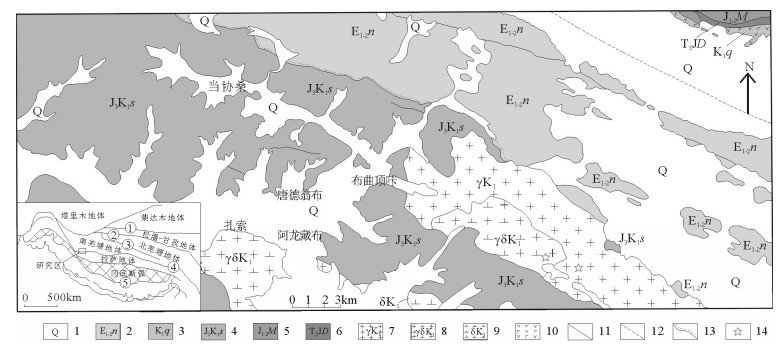
 下载:
下载:
